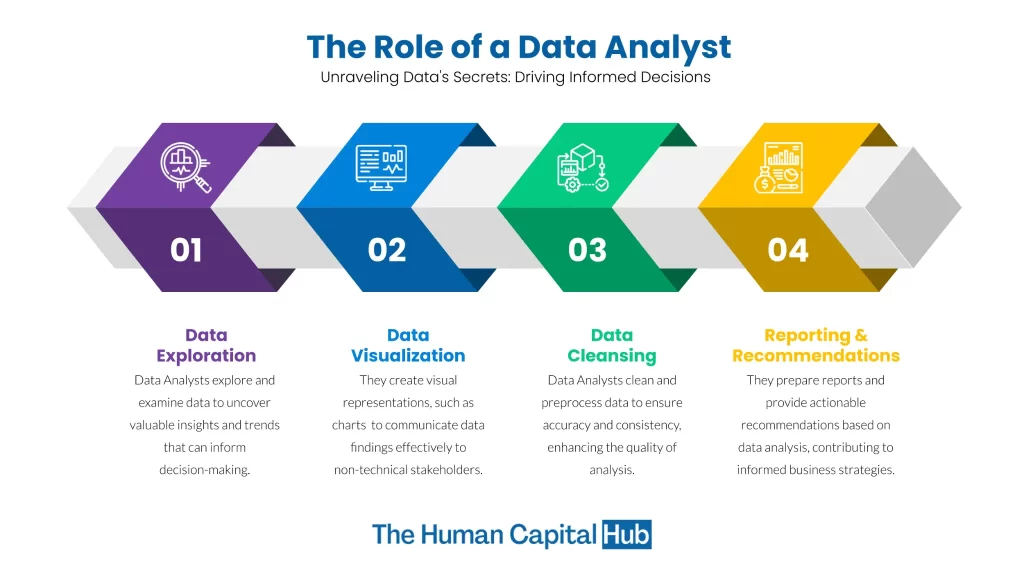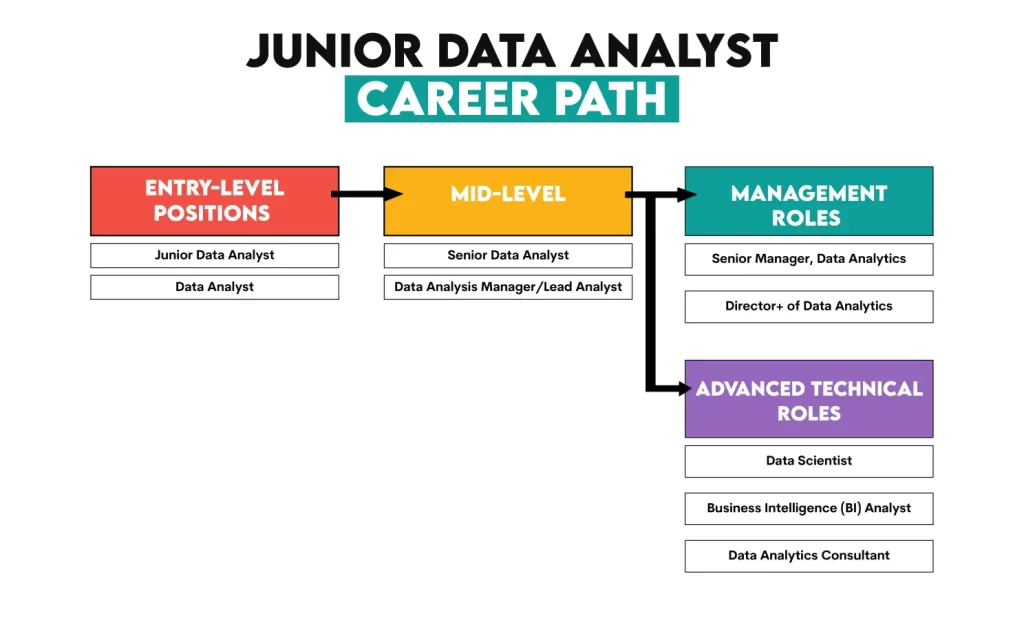How to Become a Junior Data Analyst: Beginner’s Guide [2025]
- -
- Time -

With the explosion of digital data in recent times, data analytics has become a crucial part of decision-making across all industries. As a result, the role of data analysts who can make sense of large and complex data has greatly increased in demand.
For those wanting to enter this promising field, becoming a junior data analyst is an excellent starting point. This comprehensive guide will provide everything you need to know about landing your first role as a junior data analyst. It will outline the key responsibilities of the role, dispel common myths, explore the booming job outlook, and lay out a clear roadmap for you to follow to kickstart your career in data analytics.
Table of Contents
- What is Data Analysis?
- What Does a Junior Data Analyst Do?
- Why Data Analyst?
- Types of Data Analysts
- Myth vs. Reality: Junior Data Analysts
- Junior Data Analyst Job Outlook
- Roadmap to Become a Junior Data Analyst
- How Much Can You Earn as a Junior Data Analyst?
- What Does the Career Path of a Junior Data Analyst Look Like?
- Conclusion
- FAQs
What is Data Analysis?
Data analysis is the process of inspecting, cleansing, transforming, and modeling data with the goal of discovering useful information, informing conclusions, and supporting decision-making. It involves various tasks such as mining data, finding patterns or trends within large data sets, and making inferences or predictions.
As an umbrella term, data analysis includes diverse techniques like descriptive statistics that help summarize data, predictive analytics that leverages historical facts to make predictions about future outcomes, data mining that looks for hidden patterns in large data sets, and prescriptive analytics that helps determine the best course of action. The overarching aim of all these techniques is to squeeze meaningful insights out of data through systematic investigation and exploration.
What Does a Junior Data Analyst Do?

Junior data analysts play an integral role in the data analysis process, helping to transform raw figures into meaningful insights. Some key tasks they take on include collecting data from various sources, cleansing any incomplete or inconsistent data, conducting initial analysis, and communicating findings through reports and visualizations. While more routine in nature compared to senior analysts, junior roles provide hands-on experience across the full data workflow. This well-rounded exposure sets juniors up to take their skills to the next level over time.
Why Data Analyst?
Being a data analyst, you carry out real-life problem-solving scenarios and work closely with the raw data to churn out valuable insights. With the fast pace of advancement in technology, competition among companies rises each day and they require novel tactics to compete and carry on their existence—this is where data analysts step in. You generate findings that aid organizations in deciding their future objectives and maximizing output to birth more business values.
Your role gives you a handsome salary commensurate with your expertise. Starting pay for a data analyst in India is around four lakh per annum but can skyrocket to over eighty thousand dollars per year abroad depending on experience. Multiple surveys show the demand for data analysts far surpasses the market supply and is a major reason career switchers are flocking to data science.
Types of Data Analysts
Data analysts specialize in various sectors. Business intelligence analysts interpret business data to enhance performance. Financial analysts focus on budgeting and market trends. Healthcare data analysts aim to improve patient care and medical research. Marketing analysts study consumer behavior to optimize campaigns. Operations analysts work to increase efficiency and reduce costs by analyzing operational data.
Business data analysts collect, clean, and interpret complex data sets, collaborating with stakeholders to design data blueprints and visual reports for decision-making.
Marketing analysts delve into marketing data to understand consumer behavior and refine strategies, evaluating campaigns and market trends.
Financial analysts analyze financial data to predict investment returns and economic conditions.
Healthcare data analysts focus on improving patient outcomes and advancing clinical research by studying treatment results and facility enhancements.
Operations analysts optimize processes by examining data to boost efficiency, reduce costs, and solve operational issues.
Specialists like sports, crime, environmental, and economic analysts study specific data sets to advance their fields.
Data analysts spend their days gathering, analyzing, and modeling data, often working with incomplete data to develop solutions and forecasts. They constantly adapt to new tools and techniques in this dynamic field, upskilling to meet organizational needs and advance their careers.
The role offers a challenging but rewarding career path with a significant impact, transforming data into actionable insights to enhance businesses and society. Despite strong competition, the varied roles and ongoing demand for data analysts make it a promising career choice.
Myth vs. Reality: Junior Data Analysts
As the field continues flourishing at a breakneck pace, junior data analyst positions are some of the most accessible entry points – but only if preconceptions are discarded in favor of the truthful realities awaiting below the surface.
One widespread myth that deters many is the notion coding credentials are compulsory to break into junior data analytics jobs. While proficiency with programming languages unquestionably enhances marketability, the facts paint a far more encouraging picture. Contrary to popular belief, coding expertise is certainly not a prerequisite demanded by most entry-level openings. Organizations understand that analytics newcomers are still developing specialized skill sets.
As such, positions are structured to equip fresh hires with on-the-job training rather than immediately expect wizard-level software mastery. Dataquest’s learning path exemplifies this reality, first exposing learners to Excel before methodically progressing to SQL and Python at an individualized speed. With the right educational resources, coding fluency can be attained over time rather than serving as an outright barrier to getting one’s foot in the door.
A similarly misleading myth portrays junior analyst roles as limited to menial, repetitive tasks detached from substantive problem-solving. Nothing could be further from the truth, as even entry-level positions afford opportunities to tackle important, real-world issues.
Whether assisting small organizations or massive corporations, budding analysts can immediately start analyzing pertinent datasets to pinpoint key patterns and evaluate their strategic meaning. Proper training equips newcomers to contribute value from day one rather than serving as mere order-takers. Problem-solving ability lies at the heart of the analyst function, irrespective of experience level.
Junior Data Analyst Job Outlook
The future is exceedingly bright for those aspiring to be junior analysts. Demand for data professionals currently far outweighs supply and will continue escalating for the foreseeable future as more companies leverage analytics.
Such explosive growth means abundant job openings, strong earning potential despite lack of experience, and excellent prospects for career progression into specialized or leadership analyst roles in just a few years. Simply put, becoming a junior data analyst offers a highly promising career path for the modern age.
Roadmap to Become a Junior Data Analyst
Now that you understand both the realities of junior analyst work as well as the tremendous market opportunity it presents, here is a step-by-step roadmap to help guide your journey:
Pick up fundamental data analytics skills
To kick start your transition, the first order of business is to pick up on the fundamental data analytics skills that form the core toolbox any aspiring analyst needs in their arsenal. Hone in on learning essential software such as Microsoft Excel which will allow you to get to grips with basic data formatting and manipulation.
Additionally, gear yourself up with database knowledge by digging into Structured Query Language (SQL) to grasp how to extract insights by drilling down into complex relational databases. Round off your technical skill set by dabbling in programming languages like Python that will equip you with the coding literacy expected of modern data practitioners.
While self-learning routes via online resources are viable options, structured educational programs such as online courses offer the benefit of guided learning under expert tutelage.
Work on hands-on projects
Once you’ve got the basic theory down, it’s time to put those freshly acquired skills to the test. The best way to truly hone your abilities is by throwing yourself headfirst into real-world data challenges. Scour the internet for publicly available datasets and use them to power through sample projects that allow you to practice your craft.
Be sure to build a compelling portfolio by showcasing a variety of completed freelance or academic works that demonstrate your proficiency in tasks such as extracting insights, visualizing trends, and communicating findings. This hands-on experience will go a long way in standing out to potential employers.
Consider internships
As you gain more ground, consider leveraging internship opportunities as a stepping stone. While unpaid gigs are legally permitted, they offer invaluable real-world exposure to onboard you in workflow particulars and the day-to-day responsibilities of a data analyst.
Use this testing ground to get a sense of cultural fit within organizations while networking extensively. With luck, outstanding performance could potentially lead to some internships to fast-track into full-time analyst roles.
Improve your online presence
To spread your online presence, pump up your professional brand on platforms revolving around the data sphere. Craft compelling profiles on networking giants like LinkedIn that highlight relevant skill sets and allow you to forge new connections. Similarly, host your portfolio of coding projects on repositories like GitHub to show technical acumen.
Additionally, consider carving a niche as a data-focused blogger by writing insightful articles exploring industry trends, analyzing datasets, or documenting self-learning journeys – helping establish thought leadership and expanding your reach.
Craft the perfect resume
When eyeing specific job postings, it is crucial to meticulously finesse your resume. Go beyond merely listing technical proficiencies to stand out from the ever-growing crop of analysts. Carefully highlight keywords associated with roles to directly address requirements.
Most importantly, tailor each application by customizing resumes and cover letters based on the nuanced needs of unique employers showcasing how you perfectly fit the bill.
Practice your interview skills
As interviews loom, polish presenting skills through mock sessions. Role-play answering commonly asked questions to feel at ease conveying passion for the field alongside relevant qualifications and background. A cordial, confident yet humble attitude portraying eagerness to learn coupled with stellar communication abilities to succinctly get points across will serve you very well during interactions with recruiters.
Apply, apply, apply!
Finally, with polished skills, experience and application materials in tow, it is time to cast your net far and wide. The more openings you vigorously put yourself forward for, the greater statistical probability of hooking a big catch. Stay optimistic even in the face of initial rejections which are inevitable parts of any job hunting process with perseverance being the key. With continuous effort and patience, success will eventually come knocking on your door ushering you into an exciting career in data analysis.
How Much Can You Earn as a Junior Data Analyst?
While starting salaries naturally vary by location and employer, glassdoor.com research shows the average total early career compensation for junior data analysts in the United States is approximately $60,000 per year. However, top performers or those working in very high-cost areas can earn over $75,000.
As your experience and expertise grow over the first few years, annual salaries often rise at a compounding rate as well. Additional skills like data engineering or analytics management can boost earnings even further. Despite humble beginnings, the long-term career earnings potential as a data professional is extremely lucrative thanks to continuously strong demand.
What Does the Career Path of a Junior Data Analyst Look Like?

The opportunities for upward mobility from a junior data analyst position are tremendous. After 1-3 years in an entry-level role, the most common next steps include:
- Data Analyst: With added experience comes greater independence, complex project leadership, and deeper analytical contributions.
- Senior Data Analyst: Strong technical know-how and soft skills open doors to specialized expertise, team guidance, and strategic business partnering at this advanced intermediate level.
- Business Intelligence Analyst: Some progress into roles with a sharper business focus, translating insights into decisions.
- Data Science: Top performers are headhunted into master’s and PhD qualification paths leading emerging fields like machine learning.
- Non-Technical Management: Leading entire teams or consultancy practices comes into play for especially skilled individuals.
Beyond 10 years, truly exceptional data veterans can achieve C-Suite roles influencing multi-million dollar strategic decisions throughout organizations. With lifetime learning and adaptable skills, junior analysts have virtually unlimited potential.
Conclusion
In today’s data-driven world, becoming a junior data analyst offers brimming career opportunities for both current students and professionals switching paths. Despite their entry-level nature, roles provide holistic exposure and transferable abilities valued by employers across all industries.
Combined with low barriers to entry but high earning and growth capacity, now is arguably the best time in history to join the booming field of analytics. For driven individuals committed to sharpening their skills, a challenging yet deeply rewarding data analyst career awaits. The roadmap provided serves as your starting point – the future is yours to make the most of.
At CCS Learning Academy, we understand the immense potential a career in data analytics holds. Our immersive 12-week Data Analytics & Engineering bootcamp is meticulously designed to equip you with the essential skills and knowledge needed to excel in this dynamic field.
Take the first step towards a promising career in data analytics with CCS Learning Academy. Our course is your gateway to mastering data analysis and unlocking a world of opportunities. Join us and turn your analytical potential into professional success. The future of data analytics is bright—let us help you shine.
FAQs
A Junior Data Analyst is an entry-level position in the field of data analytics where the primary role involves analyzing data to help businesses make informed decisions. This typically includes gathering data, performing preliminary analysis, and interpreting data using statistical tools.
Typically, a bachelor’s degree in data science, statistics, computer science, or related fields is required to become a Junior Data Analyst. However, candidates with degrees in other disciplines can also enter the field if they have relevant skills in data analysis, statistics, and software tools.
A Junior Data Analyst is an entry-level position in the field of data analytics where the primary role involves analyzing data to help businesses make informed decisions. This typically includes gathering data, performing preliminary analysis, and interpreting data using statistical tools.
Essential skills include a strong foundation in mathematics and statistics, proficiency in data analysis software and tools, basic programming knowledge (especially in languages like SQL, Python, or R), and good communication skills to interpret and present data insights effectively.
Gaining practical experience can be achieved through internships, entry-level jobs, or by participating in relevant projects that involve data handling and analysis. Online platforms also offer simulated projects and real-world datasets for practice.
Yes, certifications can provide foundational and advanced knowledge in data analysis. Certifications from recognized institutions in software tools, data management, and analytics can enhance a resume and demonstrate commitment and proficiency to potential employers.
A typical day might involve collecting data from various sources, cleaning and organizing data, performing basic analysis, and creating reports based on findings. Collaboration with senior analysts and other departments to understand data needs and outcomes is also common.
Junior Data Analysts can advance to positions such as Senior Data Analyst, Data Scientist, or Data Analytics Manager with experience and additional education. Continuing to learn advanced analytics techniques and software will aid in career progression.
Virtually every industry requires data analysts to some extent. Common industries include finance, healthcare, technology, retail, and government. Each industry has specific data needs and applications, providing various environments for data analysts to work in.
Prepare by understanding the specific data tools and software the company uses, familiarizing yourself with common industry-related data challenges, and being ready to demonstrate how your skills and experiences make you a suitable candidate. Practice explaining complex data concepts in simple terms.
Emerging trends include the increasing use of machine learning and artificial intelligence in data analysis, the growing importance of data privacy and ethical considerations, and the expansion of data analysis into new areas like user experience and social media analytics.






